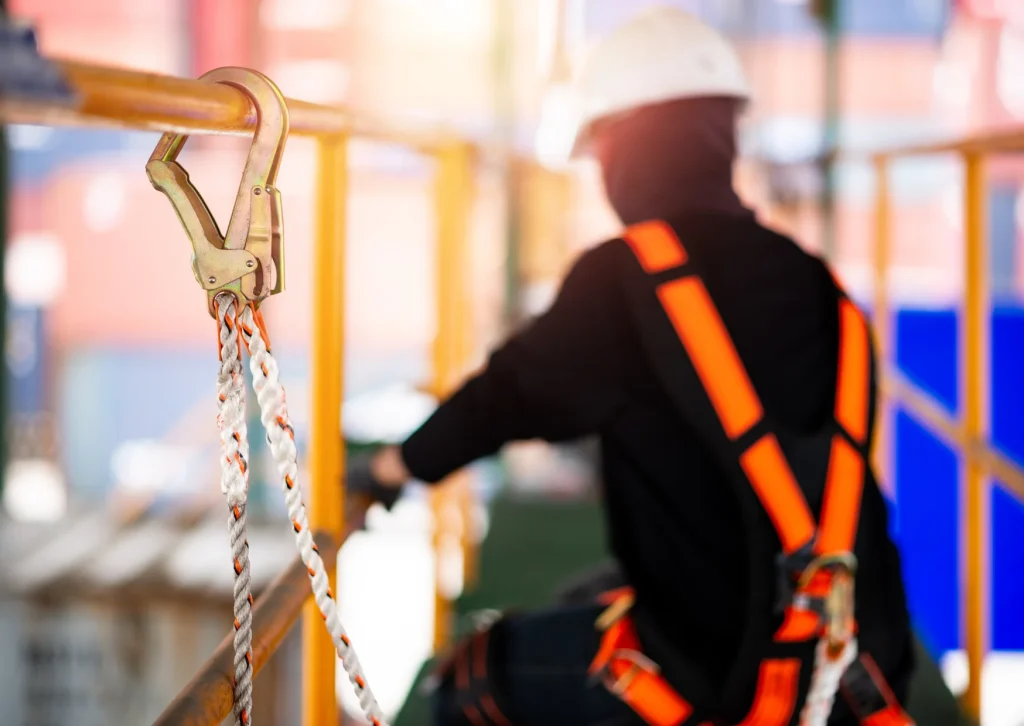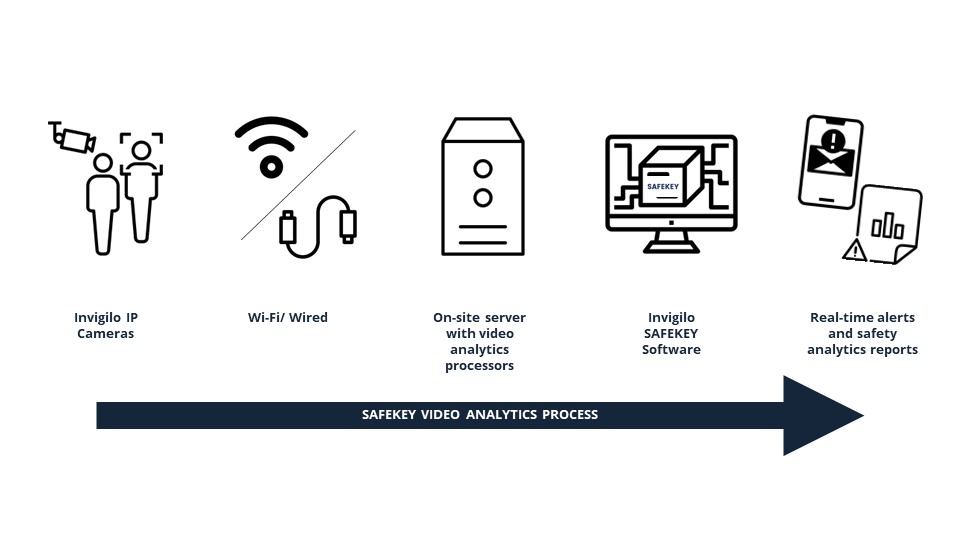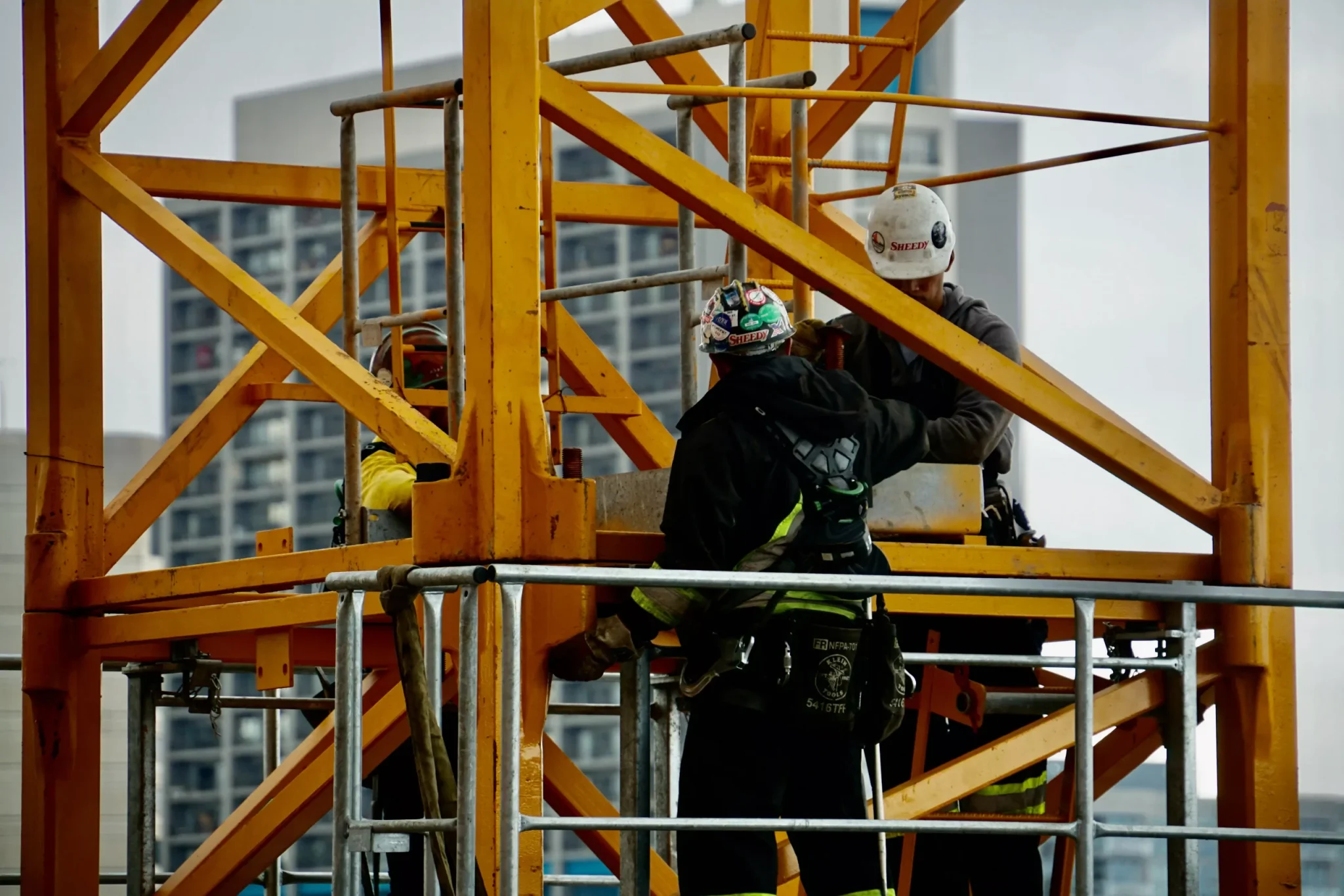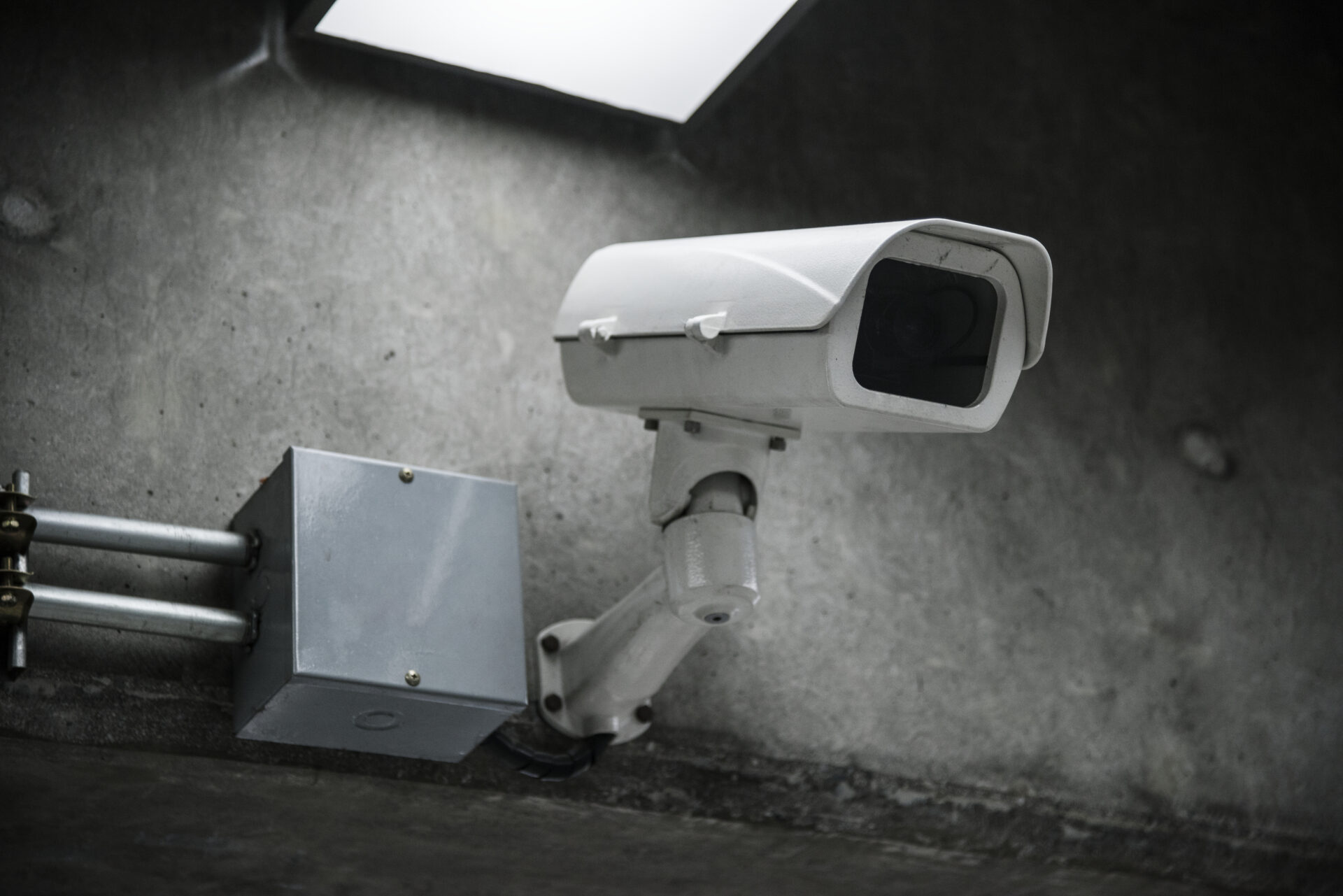
Falling from heights is extremely dangerous and can lead to severe injuries and even death, so it is necessary to improve working from heights safety. Falls are one of the top contributors to workplace fatalities. According to WSH, more than a third of the yearly total workplace fatalities are due to falls. Given that working at high places is an integral and necessary part of many industries, here are six (6) ways to improve work at height safety.
Working at Heights Safety Tip #1: Fall Prevention Plan
A fall prevention plan (FPP) is a specific plan onsite to reduce the risk of falls. WSH lists a recommendation on preventing falls and advises employers to establish safe work procedures for working at heights. This FPP includes setting up protection systems such as guardrails, scaffolds, and covers for openings.
If there are openings into or through which a person may fall more than 2 meters, this gap must be covered or guarded. It can be surrounded by adequate guardrails or barriers to prevent falls. Guardrails are stationary systems designed to protect workers from falling at heights. Guardrails and barriers are a reliable and convenient way to prevent falls. Guardrails that have been correctly set up act as a visible and physical barrier to help prevent falls from heights or between levels, including falls from roofs, balconies, stairwells, or falls into open holes. If covers, floors, or walls are not practical, guardrails are an alternative. Other barriers present in a construction site include fences, walls, and handrails.
Other safety equipment pieces for elevated surfaces include beamers, retractables, rope grabs, beam straps, butterfly anchors, concrete plunger anchors, and retractable lanyards. Anchors give the workers a point to secure themselves onto the structure, improving work at height safety. However, with so many types of fall protection equipment available for workers, it is also imperative for employers to choose the right equipment for the jobs. If the equipment is not for the right task, not only could it not prevent a fatality, it could be a contributing factor.
Working at Heights Safety Tip #2: Adequate Protective Gear
Personal protective equipment (PPE) is an essential factor that prevents accidents. Before beginning any form of work, workers need to have appropriate and adequate protective gear. Workers should wear equipment such as hard hats to alleviate the impact on the worker’s head in the event of a fall. Workers should also be wearing gloves and boots that ensure that the workers have proper grip while working. This would prevent them from falling over due to a lack of good grip.
Another specific form of PPE required when working at heights is safety harnesses and lanyards. A harness significantly reduces the possibility of falling as the workers are secured to safety rails. Therefore, providing an individual fall arrest system (harness) is beneficial. For instance, if a worker is wearing an ill-fitted harness, there is a considerable possibility of falling off.
Working at Heights Safety Tip #3: Frequent Training
Providing workers with the right equipment is not enough. Workers need proper and regular training on fall protection measures and equipment. Learning the limitations, adequate care, and equipment required is necessary. It is also crucial that workers know and understand the safety plan’s various safety requirements and procedures. This helps make workers aware of what to do to prevent falls and know what to do in an incident. Besides onboarding, frequent training is indispensable to ensure that workers receive updates on any changes in safety protocols. Safety officers can schedule weekly meetings with workers to address safety concerns and share best practices.
4. Working at Heights Safety Tip #4:
Safety Checks, Inspection, and Monitoring
Frequent inspections can ensure that workplace safety is up to standards, especially with working at heights. Firstly, an equipment quality check is necessary to ensure that the material can withstand any stresses over time. Safety officers should check that all workers are trained on anchor points usage, the right way to wear a harness, and operating the harness.
While working at heights, the safety equipment and PPE used by the workers are vital and can be the difference in the case of an accident. Thus, frequent inspections can help to ensure that the equipment is in good shape and works well. For example, ladders are used daily and should be safe and up to code, such as checking for cracks, broken or defective parts before usage. The ladder also needs to be safely positioned so that the side rails extend at least three feet above landings. Checking the ladder’s side rails is secured will also provide sturdy support and a grab device if a three-foot extension is impossible. Safety officers should also monitor to ensure that workers do not use the top three rungs or top two steps of the ladder. Another worker is present on the ground to watch the ladder and the worker.
Similarly, officers should frequently inspect other work areas to ensure fall protection measures and equipment are in place and in good condition. This also includes examining PPE for correct usage and adequate protection. By doing so. Safety officers can reduce the likelihood of accidents occurring due to equipment failure and improve work at height safety.
Working at Heights Safety Tip #5: Clean Work Environment
It is more likely for accidents to occur in unsafe workspaces. Safety officers need to ensure that the workspace is safe for workers by providing an area free of obstructions. This may require the workers to adopt unnatural positions that might put them at risk. For instance, removing debris in the work area and proper cable management may reduce the possibility of falls. Imagine a worker on a ladder and falls off due to swinging cables that have caught him off guard.
Working at Heights Safety Tip #6: Adoption of Video Analytics
With advancements in technology, the safety officer’s job can be accessible by adopting AI and video analytics. Cameras with computer vision can be installed around the construction site, allowing safety officers to view the worksite comprehensively. It would flag out improper use of personal protective equipment and alert officers. It also can identify potential danger areas and issue warnings to ensure that workers are aware. Safety officers can then take preventive actions to deter safety breaches and lower the chances of accidents. One such product is Invigilo’s SAFEKEY. It can aid safety officers in monitoring workplace safety to prevent accidents by mitigating risks. Our proprietary software analyzes safety data, detects violations, and sends real-time alerts. The software can process several images captured by cameras in a construction site and appropriately alert safety officers in the case of a breach of fall prevention measures or improper equipment usage. Hence, safety officers can employ video analytics to complement and further enhance existing efforts and safety plans, further improving work at height safety.
On the WSHA webinar, our CEO and Founder Vishnu shared how to turn workplace CCTV cameras into a Smart 24/7 work-at-height safety enforcer. He explained how Artificial Intelligence (AI) and the Internet of Things (IoT) are reshaping workplace safety, specifically on working at height safety.
Artificial Intelligence is the ability of a computer to perform tasks usually performed by humans or require human intelligence. Introducing artificial intelligence into analyzing camera footage creates video analytics software that can provide safety solutions.
Invigilo Technologies offers state-of-the-art behavior-based safety technology to solve safety concerns in the workplace, as easy as a three-step procedure. Firstly, we integrate our video analytics software with existing cameras. If required, we can also provide cameras for the worksite. The second step would be to select safety violations for the cameras to detect onsite. You may choose from our list of existing use cases or discuss your customized needs. Once installed, you’re now ready for the last step, to receive timely and automated alerts if any safety breach was detected.

The workflow process starts with the camera installed onsite. Once it captures the live movements of workers, data is transmitted to the onsite server with video analytics processors. The data is then processed and analyzed by the SAFEKEY software. Safety officers can then receive real-time notifications and take timely actions to counter any safety breaches. We can also generate safety analytics reports for future learning and protocol developments through the software.
Here are a few examples of safety violations that SAFEKEY can detect for working-at-heights safety.
1. Personal Protective Equipment (PPE) Detection
PPE is protective equipment worn to protect the workers against hazards at work. This protective gear includes protective clothing, helmet, gloves, goggles, face shields, facemasks, hard hats, vests, and boots. PPE is vital for workers to protect themselves and minimize injuries/risks they may face. This is also one of the most basic and foundational requirements for workplace safety.
Suppose a worker is not wearing the correct PPE gear or in the absence of PPE. In that case, it will alert the safety officer through an app notification to make timely preventive actions. This prevents further mishaps from occurring and overall improves the work-at-height safety.
2. Harness and Lanyard Detection
A safety harness is a specific type of PPE designed to catch a person in the event of falling while working at heights. Harness and lanyards are very common in construction sites as it is the most critical fall protection equipment. A poorly-fitted safety harness will endanger the life of the worker.
The cameras can recognize if a worker is not wearing a harness/lanyard or is wearing it incorrectly. Safety officers can then advise promptly to use the safety harness and in a correct manner while working at heights.
3. Barriers and Guardrails Detection
Placing barriers and guardrails at the workplace can significantly reduce the number of accidents and fatalities, especially at high-risk environments, e.g., construction sites and working at heights. Keep your workers safe by putting up guardrails and barriers around the worksite.
- Guardrails are reliable for fall protection. It is visible and acts as a physical barrier to help prevent falls from heights. They are usually installed between floor levels and open areas where covers and walls are not practical.
- Construction barriers such as fences, signs, and other devices can help manage traffic and provide clear separations of zones.
The camera onsite can detect two (2) main things related to barriers. It can identify if walls are absent or if there is an open area and open edges. This poses a grave danger as anyone can fall from the fringes with a slight misstep.
Another crucial observation is when workers lean on the barrier/guardrails. Although these protective railings are heavy-duty, there is still a possibility of slipping and falling off. With our cameras and video analytics recognizing such behavior, safety officers can caution workers not to rest on the fences for their safety.
4. Person under Load Detection
According to the workplace and safety regulations, a fall prevention plan should always be in place. Rules also apply to working with tower cranes and hoisted loads. For instance, if a worker is on the fifth floor of a building under construction and the crane is lifting a heavy load across the floor, workers mustn’t stand under the haul or where the unloading zone is.
With SAFEKEY, we can detect if a person is directly or near a moving load. Safety officers can guide the crane operators on the lifting and unloading process. They can also warn workers to steer clear of the unsafe zones.
We learn that AI improves construction site safety, including working at height safety. The use of deep learning aims to minimize risks and the number of accidents and fatalities by improving current safety methods. Computer vision increases onsite visibility and detects various types of non-conformance. It also reduces human error as it automates the process of safety checks and manual inspections. Predictive analysis also prevents future repeat accidents. As AI systems collect several data, it improves the model to predict and foresee risky encounters over time. Several AI-safety technologies are currently in trend, e.g., wearables such as smartwatches, smart-hard hats, and even augmented reality goggles. Business Information Modelling (BIM) also assists with the construction project management and spots hazardous areas with a high chance of accidents.
For its benefits and value-added service to support safety officers, several companies are adopting AI not only for construction site safety but other key industries as well. The list of common detections and use cases is non-exhaustive. It is readily applicable to different sectors, e.g., manufacturing, supply chain, transport and logistics, shipping, maritime, and several more.
For more information on how our video analytics can save lives in the workplace and improve workplace safety culture, follow our website and updates, and sign up now for a free and customized demo. We can show you how your cameras can be smart 24/7 safety enforcers, especially when working at heights in high-risk settings.




2 Comments
Great content! Keep up the good work!
[…] protection equipment. By doing so, workers can work safely and prevent accidents from occurring. Fall prevention equipment includes anchors, rope grabs, and retractable lanyards. Anchors secure workers onto the […]